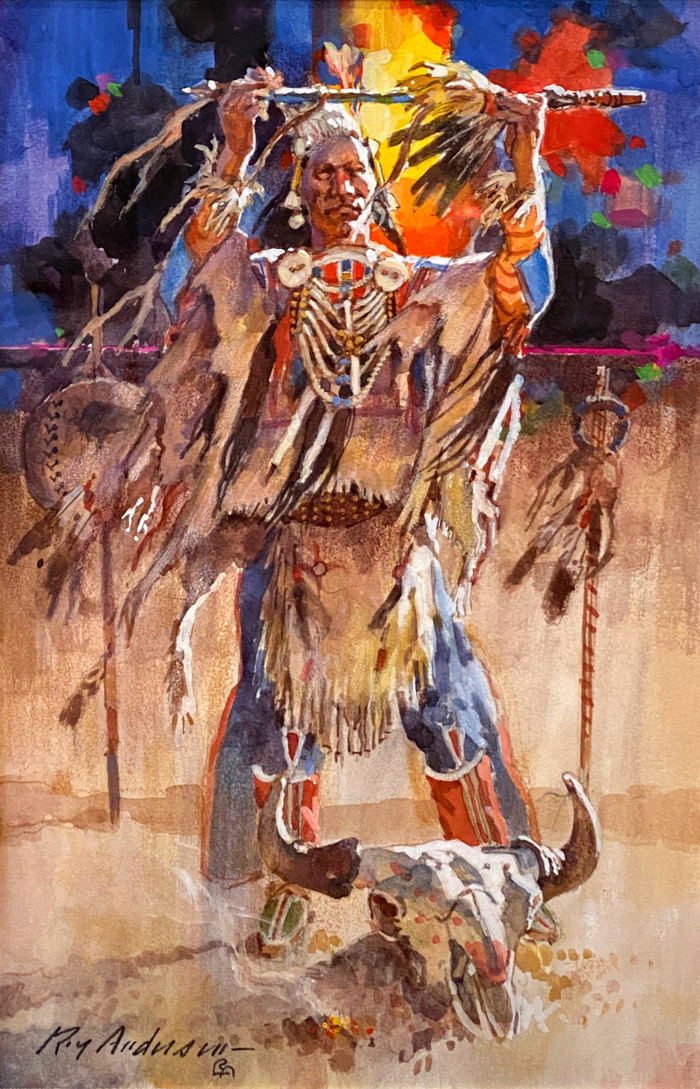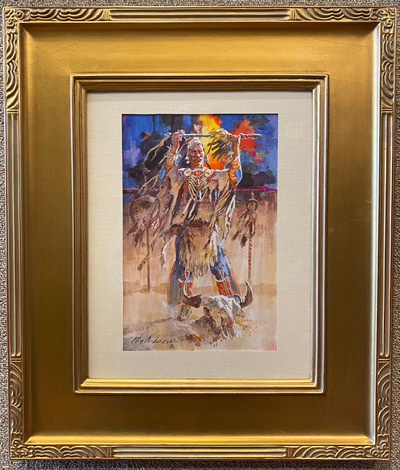In Roy Andersen’s The Medicine Pony, a Crow warrior stands in front of his white pony, holding a horse dance stick after a late afternoon rain. The man gazes toward the horizon while two other Indians wait behind him on their mounts. Painted on the white pony’s neck are symbols of dragonflies, which to the Crow people were messengers from the spirit world that carried dreams to individual warriors. “I was pretty proud of the piece,” Andersen, 82, says from his studio in Kerrville, Texas. “Some of them you struggle through, and sometimes they just paint themselves. Those are the ones that are really fun. This one went along the way I wanted.”
Authenticity is a hallmark of Andersen’s work. “I always like to try to get a little weather in my paintings,” he says of the sinking sun and afternoon rain in The Medicine Pony. The model for the white horse was a saddle horse Andersen used to own. He still uses the paint horses he raises as models. “I don’t know how many I have,” he admits. “I guess 25 or so.” Andersen also bought two longhorn steers to serve as models. “They’re pretty much pets,” he says. “I call them Gus and Woodrow, after [the characters in] Lonesome Dove.”
Growing up on a New Hampshire apple farm, Andersen had dreams of his own: “I wanted to grow up to be an Indian,” he says, “but found out that was a job I couldn’t get.” Another dream was to be an artist. “Nobody in my family had ever been that, and my parents said, ‘If that’s what he wants to be, well, we’ll try to help him.’ My father thought that I wasn’t strong enough to be a farmer and certainly not smart enough to be a carpenter, so if I wanted to be a painter, that was all right.”
Andersen studied at the Chicago Academy of Fine Arts and the Art Center School of Los Angeles, then became a professional illustrator, his work gracing National Geographic, Time and Sports Illustrated, as well as movie posters. His favorite poster was for Clint Eastwood’s The Outlaw Josey Wales (1976). “My wife was my agent then—she still is,” Andersen says. “I always told her that was my favorite job she ever got me.”
Living on the East Coast might have been good for a magazine illustrator, but Andersen’s heart belonged out West. “I was about 15 when I discovered The Field Museum in Chicago had all these cases of Indian artifacts,” he says. “I’d go down there drawing and sketching. I don’t know why, but I was always fascinated. My family’s all from Denmark, and my mother’s brother was the first to come over. His first job in the United States was a cowboy in Nebraska.”
Eventually, Andersen moved to Arizona, first Sedona—“The sunlight bouncing off those red rocks will screw a painting up faster than anything,” the painter recalls —and then Cave Creek. But the climate was hard on the horses he raises, so he moved to Kerrville. That was about 12 years ago.
Typically, Andersen will work on two or three paintings at the same time. “One on the easel, and two half-started,” he says. His inspiration comes from various sources. “Sometimes [a painting will] cook for a while,” he says. “I have sketchbooks, and I’ll scribble in there. Sometimes it’s a landscape I’ve seen and think that would be neat. I have a ton of books here, and I try to go to every museum that has Indian artifacts. I’ve collected some of my own and have had replicas made; they don’t cost as much as the real thing.”
Andersen stresses the importance of good research. “I love to do research. I guess that’s one of the reasons I hit it off with Geographic. I did a few Indian things—the first men in America, the Anasazi, and a thing on the Mayans. Course, I did space things and dinosaurs and everything else. But the Indian stuff is my main stuff.”
Source: History Online and Daily Times Obituaries
Submitted by: Ande Rasmussen

Known as a western painter, Roy Andersen did paintings of Crow, Cheyenne, and Apache Indians. He began his career living in Chicago and New York and working as an illustrator. He did numerous covers for Time Magazine including portraits of Albert Einstein and Prince Fahd. He also did illustrations for National Geographic magazine, and did a stamp series on Dogs and American Horses, and in 1984 and 1985, won Stamp of the Year Award. As a muralist, he has filled commissions for the National Park Service, the Royal Saudi Naval Headquarters, and the E.E. Fogelson Vistor Center at Pecos National Monument in New Mexico.
To pursue his talent for painting, Roy Anderson went West, living in Arizona and settling in Cave Creek. In 1990, he was voted official artist for Scottsdale's Parada del Sol, the "world's largest" horse-drawn parade commemorating the Old West.
Andersen grew up on an apple farm in New Hampshire and learned about Indian customs from his many hours spent at the Chicago Museum of Natural History. He is meticulous about being historically accurate in his paintings. Of him it was written: "There are no 'happy accidents' in an Andersen painting. He has a knowledge of his subject that is attained only through extensive research. You will not find an Apache medicine bag around a Sioux warrior's neck nor a Cheyenne carrying a rifle that is a bit too 'modern'. What you will see is accuracy, an almost uncanny sense of composition and color harmony and a strength of drawing that is remarkable. " (Dickerson)
His training is from the Chicago Academy of Fine Art and the Art Center School of Los Angeles.
Influenced by a cowboy uncle from Nebraska, he often painted cowboy scenes that his art teachers said were passé. For thirty years, he was an illustrator for National Geographic, Time magazine and Sports Illustrated and lived in New York and Chicago.
And then he "went West looking for peace and a place where he could be his own man in both his life and his art" (Prix de West, 14). He lived in Arizona and Texas. In 1989, he was voted into membership into the Cowboy Artists of America*, a group from whom he has received recognition at the annual exhibitions: Oil Painting Award, Silver, 1999 and Drawing and Other Media, Silver, 2000.
Sources:
Prix de West 2003 catalogue
Bill Dickerson, Roy Andersen, 1998 Exhibition Catalog of O'Brien's Emporium, Scottsdale, Arizona
Southwest Art magazine
Artist Files of Phoenix Art Museum Library

Roy Andersen honed a natural talent upon the whetstone of formal study at the Chicago Academy of Fine Art and the Art Center School in Los Angeles. He achieved distinction in the crowded world of illustration art; producing work for such prestigious periodicals as National Geographic, Sports Illustrated and Time. He also executed commissions for everything from Hollywood studios to the U.S. Postal Service.
During a career that spanned more than thirty years, Andersen developed the discipline and capacity for hard work that is essential to all who harbor hope for artistic success. Finally, from the need to be free, to live and to paint according to his own choosing, he took the reins in hand.
A member of th Cowboy Artists of America since 1989, Roy and his wife Lui reside outside of Kerrville, Texas.
"Indians believe life moves in circles. I return to a love of horses and the native people who lived their lives on horse back. I paint Indians not just because they are picturesque, but because they are living symbols, that express the thoughts of free men and animals moving through a natural world. They are real, serious, and honest people looking for a connection between God and their own nature and the beautiful landscape around them.
"My love is the pure joy of playing with paint. After all an artist should take pleasure in his work. My next painting will be my best one, so all you can do is tell the tale as you know it and if you err, do it on the side of a great truth....beauty."

"A long time ago a kid dreamed of being a western artist. Life is full of blind alleys and detours, but sometimes, just sometimes you end up just where you wanted to be all along. Painting the things you love."
Roy Andersen honed a natural talent upon the whetstone of formal study at the Chicago Academy of Fine Art and the Art Center School in Los Angeles. He achieved distinction in the crowded world of illustration art; producing work for such prestigious periodicals as National Geographic, Sports Illustrated and time. He also executed commissions for everything from Hollywood studios to the U.S. Postal Service.
During a career that spanned more than 30 years, Anderson developed the discipline and capacity for hard work that is essential to all who harbor hope for artistic success. Finally, from the need to be free, to live and to paint according to this own choosing, he took the reins in hand.
Asked to join the Cowboy Artists of America in 1989, Roy and his wife Lui now live on a small ranch near Ingram, Texas, where he has just moved into a new studio.
Resources include 2002 Cowboy Artists of America Exhibition catalogue





